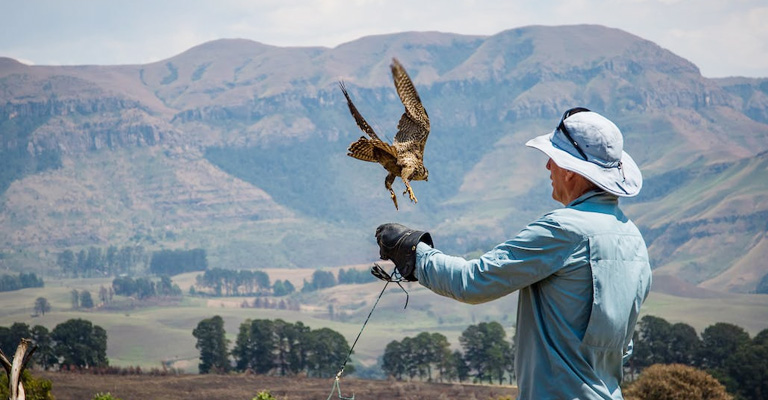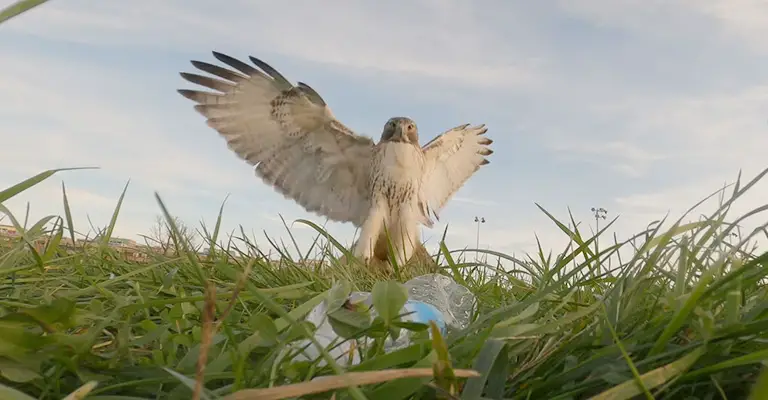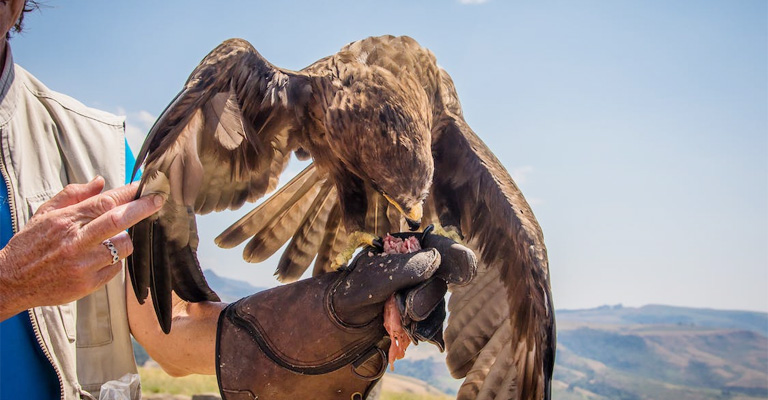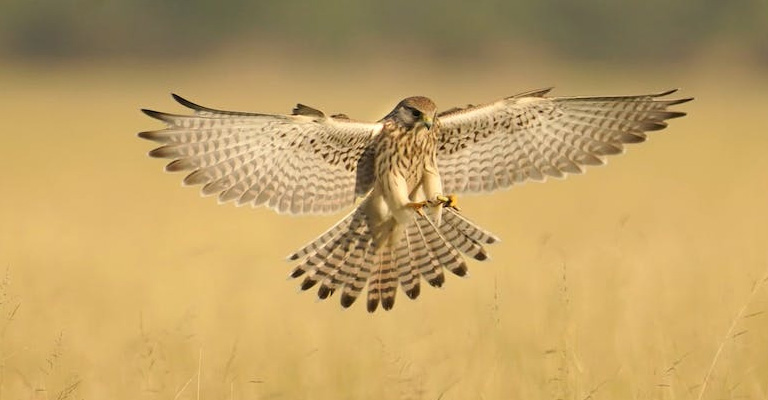Hawks are majestic birds of prey known for their keen eyesight, powerful flight, and impressive hunting abilities. One common question about hawks is that are hawks dangerous to humans.
While they primarily target smaller animals as their prey, there have been rare instances of hawks exhibiting aggressive behavior toward humans.
Understanding the nature of these incidents, the potential dangers involved, and knowing how to respond appropriately can help individuals stay safe in the unlikely event of a hawk attack.

Are Hawks Dangerous to Humans?
It is important to note that hawks generally do not pose a significant threat to humans. These birds are naturally wary of humans and tend to avoid close contact.
They prefer to hunt for small mammals, birds, reptiles, and insects in their natural habitats rather than target humans as potential prey.
Hawks are protective of their territories and may exhibit defensive behavior if they perceive a threat to their nests or young. Rarely, hawks may exhibit aggressive behavior toward humans if they feel cornered, provoked, or when defending their nests.
Such incidents are uncommon and usually occur during the breeding season when hawks are particularly territorial. While hawk attacks on humans are extremely rare, it is essential to know how to react if confronted by an aggressive hawk.
What to Do if a Hawk Attacks You?

Here’s what you can do when attacked by a hawk:
Remain Calm
It is crucial to stay calm and composed during a hawk encounter. Sudden movements or panic may further agitate the bird and escalate the situation. Avoid shouting or making loud noises, as this can exacerbate the hawk’s aggression.
Protect Your Head and Eyes
If a hawk swoops down towards you, protect your head and eyes by using your arms or any available object, such as a jacket or bag, to shield yourself. Hawks tend to target the upper body, particularly the head, so keep your head down and covered.
Retreat Slowly
Back away slowly and maintain eye contact with the hawk. Avoid turning your back on the bird, as this may provoke further aggression. Make yourself appear as small as possible by crouching down and keeping your arms close to your body.
Use Deterrents
If the hawk persists or becomes more aggressive, you can use various non-harmful deterrents to discourage it. These may include waving your arms, using a whistle or air horn, spraying water, or throwing objects near the bird (not directly at it). These actions can startle the hawk and discourage it from approaching further.
Seek Medical Attention If Necessary
Although hawk attacks rarely cause severe injuries, it is advisable to seek medical attention if you are bitten or scratched. Hawks have sharp talons that can cause puncture wounds, which may require medical evaluation and potential tetanus shots.
Preventing Hawk Encounters
While hawk attacks are rare, taking preventative measures can minimize the likelihood of an aggressive encounter. Here are some steps you can take:
Avoid Nesting Areas
Hawks are protective of their nests and may become more aggressive when their young are present. Respect their space and avoid getting too close to known nesting sites.
Do Not Feed Hawks
Feeding hawks can alter their natural behavior and may encourage them to approach humans more closely, increasing the risk of aggressive behavior.
Wear Protective Gear
If you frequently engage in outdoor activities where hawk encounters are possible, consider wearing a hat or helmet to protect your head from potential attacks.
Why Would a Hawk Attack a Human?

Hawk attacks on humans are rare occurrences, and these birds typically do not view humans as prey. However, there are a few reasons why a hawk may exhibit aggressive behavior toward humans:
Defense of Territory
Hawks are territorial birds, especially during their breeding season. They may perceive humans as a threat to their nests, young, or established territory.
If a hawk feels that its nesting site or offspring are endangered, it may display defensive behavior, which could potentially lead to an attack.
Perception of Threat or Provocation
Hawks have excellent eyesight and can be sensitive to sudden movements or perceived threats. If a human unknowingly approaches too closely to a hawk’s nest or invades its personal space, the hawk may interpret it as a threat and respond aggressively to protect itself or its offspring.
Misidentification or Confusion
In rare cases, a hawk may mistake a human for its natural prey due to factors such as distance, lighting conditions, or camouflage. This situation is highly unusual but can occur when a hawk is hunting in an unfamiliar environment or encounters a human unexpectedly.
Previous Negative Experiences
In certain instances, hawks that have had negative interactions with humans, such as being trapped, injured, or harassed in the past, may develop a heightened fear or aggression towards humans. These individual cases are not representative of the behavior of Hawks as a whole.
It is important to note that the likelihood of a hawk attacking a human is still extremely low. Hawks are generally more interested in hunting and maintaining their territories than engaging in aggressive encounters with humans.
Understanding and respecting their natural behavior, as well as keeping a safe distance from nesting sites, can help minimize the chances of any potential conflicts.
What are Hawks Afraid Of?

Hawks are naturally wary creatures and have certain instincts that make them cautious and alert. While they may not be “afraid” in the same way humans experience fear, there are several things that hawks tend to avoid or find intimidating. Here are some factors that can deter or unsettle hawks:
Larger Birds of Prey
Hawks have their own predators, including larger raptors such as eagles, owls, or falcons. The presence of these larger birds can make hawks feel threatened and may cause them to leave an area.
Visual Deterrents
Hawks are often deterred by visual stimuli that they associate with danger. This includes shiny objects, bright lights, or moving devices. Reflective materials, like aluminum foil or reflective tape, can create an intimidating effect and discourage hawks from approaching.
Loud Noises
Hawks are sensitive to loud and sudden noises. Sounds such as air horns, clapping, or whistling can startle and unsettle them, prompting them to fly away from the source of the noise.
Predatory Animals
Hawks are aware of potential threats from ground predators such as foxes, raccoons, or dogs. The presence of these animals can make hawks uneasy and encourage them to find safer areas.
Human Presence
While hawks have adapted to human presence in many environments, they generally try to avoid close encounters with humans. Human activity, noise, and movement can be perceived as potential threats, causing hawks to keep their distance.
Unpredictable or Aggressive Behavior
Sudden and unpredictable movements or aggressive behavior from humans or other animals can startle and intimidate hawks. They prefer to avoid confrontations and will likely retreat to a safer location.
It is important to note that while these factors can deter hawks, individual responses may vary depending on the species, context, and level of habituation to human presence.
Respecting their natural behavior and maintaining a safe distance is generally the best approach for coexisting peacefully with these magnificent birds.
How Do You Scare Hawks Away?
Scaring hawks away can be done using various non-harmful methods. Here are some effective techniques to deter hawks and encourage them to leave an area:
Visual Deterrents
Hawks are sensitive to visual stimuli. Hang shiny objects, such as aluminum foil strips, reflective tape, or old CDs, near areas where hawks are not wanted. The light reflecting off these items can startle and deter hawks from approaching.
Auditory Deterrents
Loud noises can be effective in scaring away hawks. Use devices like air horns, whistles, or bird distress calls to create sudden and unexpected sounds. The noise will startle the hawk, making it uncomfortable and encouraging it to leave the area.
Motion-Activated Sprinkler
Install motion-activated sprinkler systems in areas frequented by hawks. When the hawk approaches, the sudden spray of water will surprise and discourage it from staying in the area.
Scarecrow or Decoy Models
Set up a scarecrow or decoy hawk model in the vicinity. The presence of a potential predator can deter hawks from approaching, as they may perceive it as a territorial threat.
Physical Barriers
If you have a specific area you want to protect from hawks, consider using physical barriers like netting or fencing. This is particularly useful for protecting small livestock or poultry enclosures.
Habitat Modification
Make the area less appealing to hawks by removing potential food sources. Keep areas clear of rodents or other small animals that may attract hawks as prey. Additionally, trimming trees or shrubs can reduce perching opportunities for hawks.
Remember, it is important to check local regulations regarding bird deterrence techniques, as some methods may be restricted in certain areas or protected for migratory bird species.
It is always advisable to prioritize non-harmful methods that respect the natural behavior of hawks while encouraging them to find alternative habitats away from human-populated areas.
FAQs
No, there are no specific species of hawks that are known to be more prone to attacking humans. Hawk attacks on humans are extremely rare and can occur with any species of hawk. It is important to remember that hawks generally avoid human interaction and prefer to hunt for their natural prey.
A defensive hawk typically exhibits warning signs before resorting to an attack. These signs may include vocalizations, wing-flapping, or diving near a perceived threat. An aggressive hawk, on the other hand, may initiate an attack without clear warning signs.
Hawk attacks can occur in various locations, but they are more likely to happen in areas where hawks have established their nesting territories. These territories can include wooded areas, forests, open fields, and even urban environments.
Laws regarding self-defense against wildlife can vary depending on your jurisdiction. In general, if a hawk attacks you, you are permitted to defend yourself using non-lethal methods to deter the bird.
To prevent conflicts with hawks, it is important to promote coexistence and respect their natural behavior. Avoid feeding hawks or providing them with easy access to human-associated food sources.
Bottom Line
So, are hawks dangerous to humans? While the chances of a hawk attacking a human are incredibly low, it is still important to understand how to respond if such an incident occurs.
Remaining calm, protecting your head and eyes, retreating slowly, and using non-harmful deterrents can help mitigate the situation.
By respecting the natural behavior and territory of hawks, and taking preventative measures, humans and hawks can coexist safely in their shared environments.